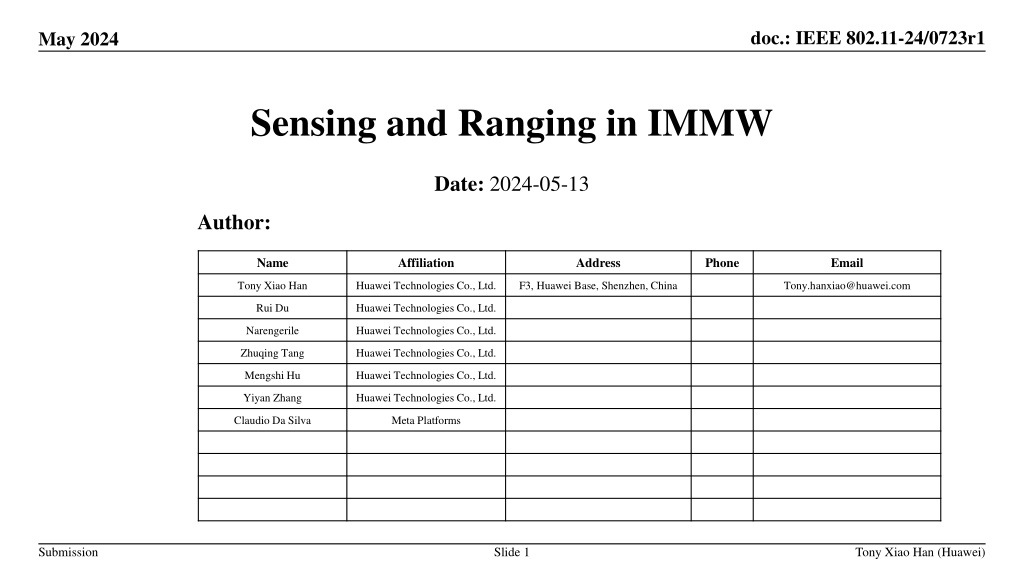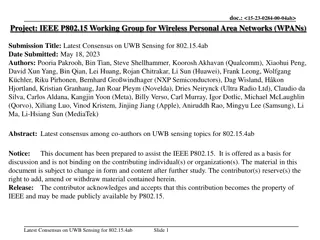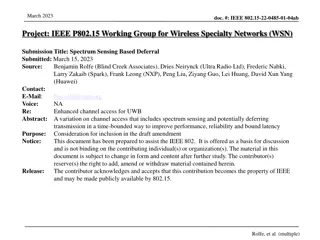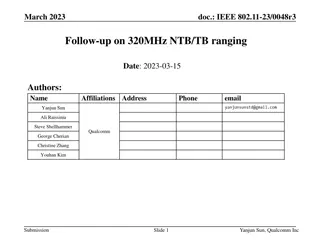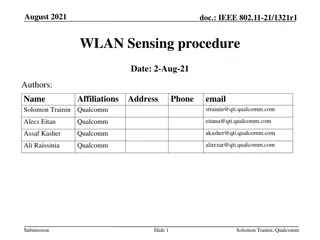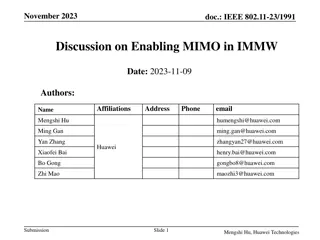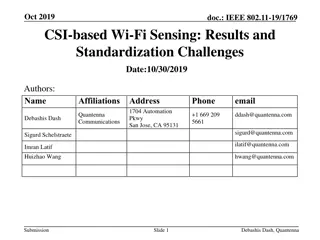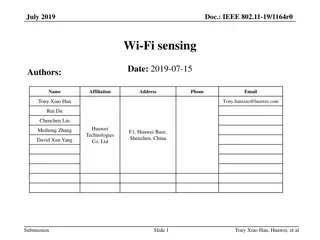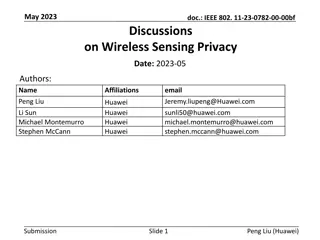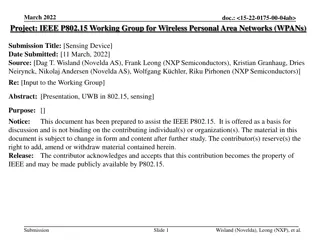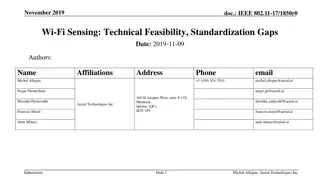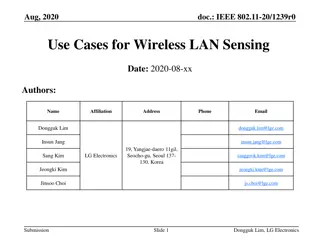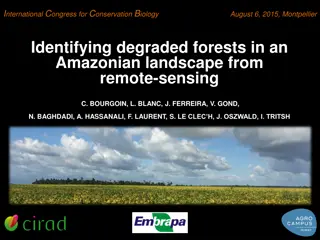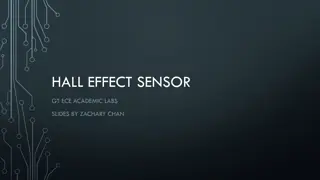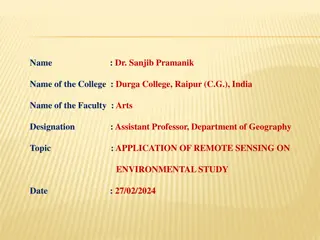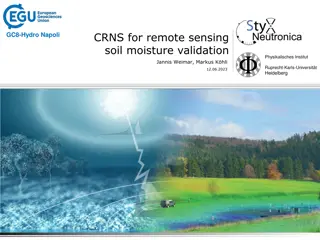Sensing and Ranging in IMMW
This document discusses Sensing and Ranging in IMMW, authored by Tony Xiao Han from Huawei Technologies. It addresses technology advancements in the field, specifically focusing on the IEEE 802.11 standards for wireless communication systems. The content provides insights into key aspects such as signal processing, protocol development, and implementation challenges. The information shared is valuable for professionals working in the telecommunications and networking industries, offering a detailed perspective on the latest developments.
Download Presentation

Please find below an Image/Link to download the presentation.
The content on the website is provided AS IS for your information and personal use only. It may not be sold, licensed, or shared on other websites without obtaining consent from the author.If you encounter any issues during the download, it is possible that the publisher has removed the file from their server.
You are allowed to download the files provided on this website for personal or commercial use, subject to the condition that they are used lawfully. All files are the property of their respective owners.
The content on the website is provided AS IS for your information and personal use only. It may not be sold, licensed, or shared on other websites without obtaining consent from the author.
E N D
Presentation Transcript
doc.: IEEE 802.11-24/0723r1 May 2024 Sensing and Ranging in IMMW Date: 2024-05-13 Author: Name Affiliation Address Phone Email Tony Xiao Han Huawei Technologies Co., Ltd. F3, Huawei Base, Shenzhen, China Tony.hanxiao@huawei.com Rui Du Huawei Technologies Co., Ltd. Narengerile Huawei Technologies Co., Ltd. Zhuqing Tang Huawei Technologies Co., Ltd. Mengshi Hu Huawei Technologies Co., Ltd. Yiyan Zhang Huawei Technologies Co., Ltd. Claudio Da Silva Meta Platforms Slide 1 Submission Tony Xiao Han (Huawei)
doc.: IEEE 802.11-24/0723r1 May 2024 Overview In this contribution, we would like to consider Sensing and Ranging in IMMW. Some general design consideration are given. Slide 2 Submission Tony Xiao Han (Huawei)
doc.: IEEE 802.11-24/0723r1 May 2024 Definition WLAN Sensing (802.11bf) [1] WLAN sensing is the use of received WLAN signals to detect feature(s) of an intended target(s) in a given environment. Features = Range, velocity, angular, motion, presence or proximity, gesture, etc. Target = Object, human, animal, etc. Environment = Room, house, car, enterprise, etc. WLAN Ranging (802.11az/bk) [2, 3] A Station to identify its absolute and relative position to another station or stations it s either associated or unassociated with. Better accuracy with respect to the Fine Timing Measurement (FTM) protocol. For Sub 7GHz (11ac/ax), and 60GHz (11ad/ay) For Sub 7GHz (11n/ac/ax), and 60GHz (11ad/ay) IMMW [4] Slide 3 Submission Tony Xiao Han (Huawei)
doc.: IEEE 802.11-24/0723r1 May 2024 Motivation Sensing and Ranging for IMMW Feature: Similar as 802.11bf/az/bk for WLAN, Sensing and Ranging also could be the unique/highlight features in IMMW Market: Based on the addressable market for WLAN Sensing [8], Sensing and Ranging could further enable the commercialization of IMMW Pre-standard (2024-2025) It is anticipated that there will be a rapid increase in the number of WLAN Sensing compatible devices. Because of the arrival of pre-standardization 802.11bf chipsets Official 802.11bf standardization (2025-2026) Additional growth is expected following the official 802.11bf Standard releases Well-defined requirements and market demand encourage more chipset vendors to adopt 802.11bf for their chipsets IMMW for Sensing and Ranging Requirement: Some use cases may need mmWave, e.g., For Sensing: Audio with user tracking, fine-grained gesture recognition, etc. [7, 8] For Ranging: Device Proximity Detection, Nano Location in store, etc. [9] Current: standardized mmWave Sensing and Ranging is based on 11ad/ay Potential: IMMW may be a good candidate (Unified baseband for sub-7GHz and mmWave) to supplement the mmWave part, with higher commercialization possibility. 802.11bf Sub7GHz mmWave May not be implemented IMMW Supplement 802.11az Sub7GHz mmWave Slide 4 Submission Tony Xiao Han (Huawei)
doc.: IEEE 802.11-24/0723r1 May 2024 Procedure & Technology in 802.11bf [5] Consider as reference Consider as baseline Need to redesign IMMW sensing and only take DMG sensing as reference, but not revise based on DMG sensing No need to redesign 802.11bf have well defined protocol for Sensing, no need to completely redesign Minimize redesign according to IMMW architecture Sensing (Sub-7GHz): Consider as baseline; DMG sensing (60GHz): Consider as reference Slide 5 Submission Tony Xiao Han (Huawei)
doc.: IEEE 802.11-24/0723r1 May 2024 Initial design consideration (Sensing) IMMW sensing procedure IMMW sensing IMMW sensing types IMMW sensing procedure 1. Minimize modification of 11bf, according architecture to IMMW 1. Consider really necessary types 2. Consider Multi-Link Operation 2. Others? 3. Others? Sensing by proxy (SBP) Technology Robustness Signal proc & Feedback Efficiency Multi-Link Waveform/Sequence design Channel modeling RX operating point/ RF/Analog/Digital gain Sensing availability window or Multiple sensing measurement sessions Other? Reuse newly designed NDP (Reuse) Q TX power Ray-tracing- based DDHC- based Other? CSI Other? TBD matrix Slide 6 Submission Tony Xiao Han (Huawei)
doc.: IEEE 802.11-24/0723r1 May 2024 802.11az Key Radio and Positioning Techniques [6] Medium efficient operation via dynamic (demand dependent) measurement rate. Adaptation to next generation mainstream 802.11ax Trigger Based Operation (MIMO, Trigger Frame, NDP frame) Authenticity and privacy and anti-spoofing mechanism via PMF in the unassociated mode and PHY level randomized measurement sequences (HE LTF sequences protection). Improved accuracy via MIMO and larger BW available in the <7Ghz band for 11ax. MIMO enablement for measurement for improved accuracy especially for NLOS or NNLOS conditions. Passive location with fixed overhead independent of number of users 802.11az (bk) have well defined protocol for Ranging, we do not need to redesign it again Slide 7 Submission Tony Xiao Han (Huawei)
doc.: IEEE 802.11-24/0723r1 May 2024 Procedure & Technology in 802.11az/bk Consider as reference Consider as baseline Need to redesign IMMW ranging and only take DMG ranging as reference, but not revise based on DMG ranging No need to redesign 802.11az/bk have well defined protocol for Ranging, no need to completely redesign Minimize redesign according to IMMW architecture Ranging (Sub-7GHz): Consider as baseline; DMG Ranging (60GHz): Consider as reference Slide 8 Submission Tony Xiao Han (Huawei)
doc.: IEEE 802.11-24/0723r1 May 2024 Initial design consideration (Ranging) IMMW ranging procedure IMMW ranging IMMW ranging IMMW ranging procedure Measurement exchange variants 1. Minimize 11az/bk, according to IMMW architecture modification of 1. Consider really necessary types 2. Consider Multi-Link Operation 2. Others? 3. Others? Technology Robustness Signal processing and feedback Efficiency Multi-Link Waveform/Sequence design Security Multiple ranging measurement sessions Other? Reuse newly designed NDP Secure XXX LTF TOA TOD DMG First path BFT Availability window Phase shift AOA AOD DMG LOS assessment Secure XXX LTF Other TBD PASN Slide 9 Submission Tony Xiao Han (Huawei)
doc.: IEEE 802.11-24/0723r1 May 2024 Summary There is strong motivation to add Sensing and Ranging in IMMW Sensing and Ranging for IMMW IMMW for Sensing and Ranging In order to add Sensing and Ranging in IMMW, we could consider the following design logic Sensing (Sub-7GHz) in 802.11bf could be considered as baseline, but no need to redesign Sub-7GHz sensing; Need to redesign IMMW sensing and only take DMG sensing (60GHz) in 802.11bf as reference, but not revise based on DMG sensing Ranging (Sub-7GHz) in 802.11az/bk could be considered as baseline, but no need to redesign Sub-7GHz ranging; Need to redesign IMMW ranging and only take DMG ranging (60GHz) in 802.11az/bk as reference, but not revise based on DMG ranging Minimize redesign according to IMMW architecture Slide 10 Submission Tony Xiao Han (Huawei)
doc.: IEEE 802.11-24/0723r1 May 2024 Reference [1] https://www.ieee802.org/11/Reports/tgbf_update.htm [2] https://www.ieee802.org/11/Reports/tgaz_update.htm [3] https://www.ieee802.org/11/Reports/tgbk_update.htm [4] https://mentor.ieee.org/802.11/dcn/24/11-24-0116-02-immw-immw-draft-proposed-par.docx [5] Du R, Hua H, Xie H, Song X, Lyu Z, Hu M, Xin Y, McCann S, Montemurro M, Han TX, Xu J. An overview on IEEE 802.11 bf: WLAN sensing. arXiv preprint arXiv:2310.17661. 2023 Oct 20. [6] http://www.kt.agh.edu.pl/~kulakowski/evolution/09_wifi2.pdf [7] https://mentor.ieee.org/802.11/dcn/20/11-20-1712-02-00bf-wifi-sensing-use-cases.xlsx [8] https://go.abiresearch.com/lp-the-commercial-market-value-for-wifi-sensing, Andrew Zignani, Andrew Spivey, ABI research, December 2022 [9] https://mentor.ieee.org/802.11/dcn/16/11-16-0137-04-00az-ngp-use-case-document.pptx Slide 11 Submission Tony Xiao Han (Huawei)
doc.: IEEE 802.11-24/0723r1 May 2024 SP 1 Do you agree that sensing and ranging support/operation should be defined in IMMW? Slide 12 Submission Tony Xiao Han (Huawei)
